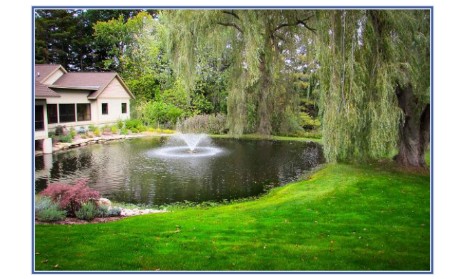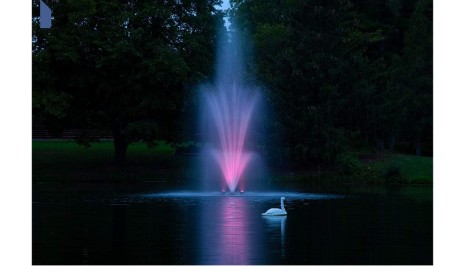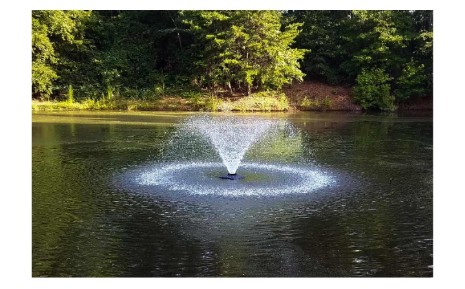Regardless of whether a pond is located in a private backyard, golf course, or municipality park, the right floating pond fountain can improve the looks and usefulness of the pond. In addition to enhancing the beauty, a good fountain aids in maintaining water quality by supporting aeration and circulation.
As with every floating fountain feature, various designs and pieces are available to choose from which means the right selection is not simple. Knowing the size, pump power, spray patterns, maintenance, lighting, material durability, and energy efficiency will guide you in picking the best option.
Pond Size and Depth
Floating pond fountains can improve the aesthetic appeal and even bring benefits to the ecosystem under the right conditions. One of the factors you need to consider when setting up the floating pond fountain is the size and depth of the pond. So, too shallow of water leads to insufficient aeration, while too deep limits the skill set of the fountain. Additionally, a big pump is perfect for big ponds. But when it comes to small ones, it gets tricky because, strategically placed, a small pump could very easily start overpowering any natural current present.
Pump Power and Water Circulation

Without proper water circulation, the fountain’s beauty will go unnoticed. To avoid such things the power of the pump can be adjusted according to need; higher power ones ensure proper aeration and circulation, while moderate level pump power for deep water bodies can work for small water fountains, while a level above a certain horse power level is best suited for larger ponds. Proper pump control brings out aesthetic beauty and also gives water natural flow and balance.
Spray Pattern and Aesthetic Appeal
The aesthetic features and the spray pattern fuse together with the elegance of a fountain. Floating pond fountains come in different designs with spray patterns including single-tier, multi-tiered, and wide arching designs. Some fountains allow for greater user control by enabling the interchange of nozzles to different spray styles. As for how the nozzles define the pond’s beauty, consider how the fountain’s spray pattern aligns with the landscape. Additionally, the spray height and the spray range should be proportional to the pond’s size to restrict excessive water loss because of wind dispersion.
Maintenance Requirements
Regular maintenance is required to maintain the floating pond fountain’s optimal performance. Before you buy the fountain, assess its maintenance needs and ensure you can do a few things for regular upkeep. Some of the fountains need frequent cleaning of the filters and nozzles, for they might get clogged by debris, algae, and sediment. It’s easy for inexperienced users to ignore more complex tasks such as cleaning a model with accessible components and Easy to Clean parts. This can be helpful for beginners. Also, when prolonging the fountain’s lifespan, search for less maintenance effort features such as clog-resistant intake screens.
Choosing the Right Lights for A Floating Fountain

Illuminating a floating fountain on a pond adds value and boosts its decor during sacrosanct hours. Lights make the evening scene picturesque and calm. Most fountain lights have built-in LED systems that come in various colors and intensities. A fountain with adjustable lights lets the user customize its appearance to suit specific occasions. LED lights are cost-efficient and energy-saving because they consume less power and have a longer lifespan.
Construction Material and Durability
The lifespan and sturdiness of a floating pond fountain will depend on the materials used in its construction. Good quality fountains are usually assembled from materials that do not corrode with the passage of time, like stainless steel, heavy-duty plastic, and marine-grade aluminum. All these materials can easily withstand long-term contact with water, UV radiation, and drastic weather conditions. A robust fountain ensures the device continues to function well and look great over time. It also helps in reducing the frequency of replacements.
Importance of Energy Efficiency and Operating Expenses
When selecting floating pond fountains, energy efficiency should be a determining factor because their continuous operation may lead to expensive electricity bills. Environmentally-conscious consumers will especially appreciate some models that come with variable-speed pumps, allowing the adjustment of water flow and power usage. Some models include energy-efficient pumps that contribute to long-term expenses and environmental impacts. Also, propulsion systems that derive power exclusively from solar energy thus cutting all electrical connections, can be considered eco-friendly.
Conclusion
When determining the appropriate floating pontoon fountain, the user must analyze its maintenance requirements, dimensions, pump capacity, energy efficiency, spray designs, lighting features, and materials. The best fountains should be easy to maintain, visually appealing, energy-efficient, and constructed from high-quality materials that do not weather over time.
Failure to properly select a fountain may decrease the pond’s aesthetics, making it less attractive and less beneficial for its health by hindering its ability to vent and circulate the best water. Finding the ideal floating fountain for ponds can be easily accomplished by evaluating the details of the pond’s visual and practical needs.

